
The Cathedral of the Dormition, also known as the Assumption Cathedral or Cathedral of the Assumption, is a Russian Orthodox church dedicated to the Dormition of the Theotokos. It is located on the north side of Cathedral Square of the Moscow Kremlin in Russia, where a narrow alley separates the north from the Patriarch's Palace with the Twelve Apostles Church. Separately in the southwest, also separated by a narrow passage from the church, stands the Palace of Facets. The cathedral is regarded as the mother church of Muscovite Russia. In its present form it was constructed between 1475 and 1479 at the behest of the Moscow Grand Duke Ivan III to a design by the Italian architect Aristotele Fioravanti. From 1547 to 1896 the coronation of Russian monarchs took place here. In addition, the cathedral is the burial place for most of the Moscow Metropolitans and Patriarchs of the Russian Orthodox Church; it also serves as a part of Moscow Kremlin Museums.
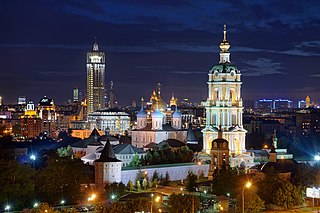
Novospassky Monastery is one of the fortified monasteries surrounding Moscow from the south-east. Like all medieval Russian monasteries, it was built by the Russian Orthodox Church.

Ukrainian Baroque, or Cossack Baroque or Mazepa Baroque, is an architectural style that was widespread in the Ukrainian lands in the 17th and 18th centuries. It was the result of a combination of local architectural traditions and European Baroque.
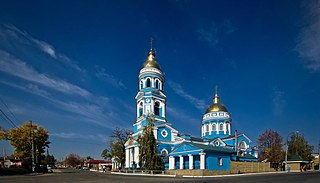
Izium or Izyum is a city on the Donets River in Kharkiv Oblast, eastern Ukraine. It serves as the administrative center of Izium Raion. Izium hosts the administration of Izium urban hromada, one of the hromadas of Ukraine. It is about 120 kilometres (75 mi) southeast of the administrative center of the oblast, Kharkiv. Izium had a population of 44,979.

Cathedral Square or Sobornaya Square is the central square of the Moscow Kremlin where all of its streets used to converge in the 15th century.

Uspenski Cathedral is a Greek Orthodox or Eastern Orthodox cathedral in Helsinki, Finland, and main cathedral of the Orthodox Church of Finland, dedicated to the Dormition of the Theotokos. Its name comes from the Old Church Slavonic word uspenie, which denotes the Dormition. It is the largest Greek Orthodox church in Western Europe.
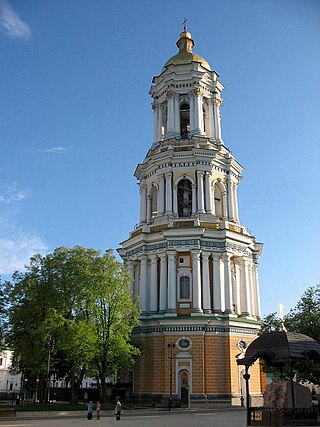
The Great Lavra Bell Tower or the Great Belfry is the main bell tower of the ancient cave monastery of Kyiv Pechersk Lavra in Kyiv, the capital of Ukraine. It is one of the most notable buildings of the Kyiv skyline.
Cathedral of the Dormition of the Theotokos or Cathedral of the Dormition of the Mother of God may refer to:

Zabrama is a rural locality in Klimovsky District, Bryansk Oblast, Russia. It is located on the river Snov. A few buildings belonging to the Kamenka Assumption Monastery still stand in the village.

Yakov Grigorievich Bukhvostov, a serf of Russian boyar Mikhail Tatishchev, designed the so-called "octagon on cube" churches in the Naryshkin Baroque mode. He was active in the 1690s in Moscow and Ryazan, where he supervised the construction of the new Dormition Cathedral in the kremlin. His tower churches in Ubory and Troitse-Lykovo "may owe something to prototypes in wooden Russian architecture". They are built of brick and decorated with profuse white stone ornamentation. A soaring white tower in front of New Jerusalem Monastery was also built from Bukhvostov's designs. Other buildings attributed to him include the Fili and Zyuzino churches. Some of the attributions are far fetched, since "there is documentary evidence of his being in charge of constructing only a handful of buildings".
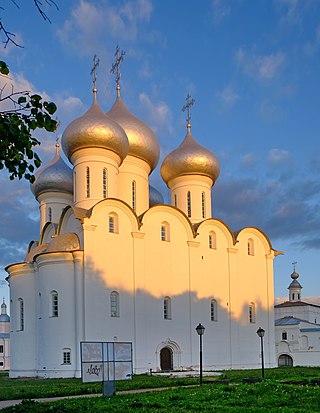
Saint Sophia Cathedral is the oldest surviving building in the city of Vologda and the main church of the Vologda Eparchy of the Russian Orthodox Church. It was constructed between 1568 and 1570 at the behest of Ivan the Terrible who had made Vologda the centre of his personal demesne. The cathedral is located on the right bank of the Vologda River, just outside the former citadel known as the Vologda Kremlin.
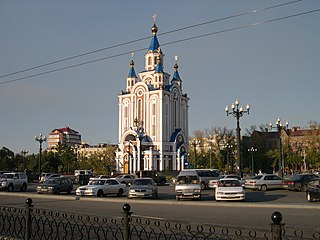
The Dormition Cathedral of Khabarovsk is a Russian Orthodox cathedral. It is one of the largest churches in the Russian Far East, and was built in 2000–02 to a design by Yuri Podlesny, a local architect.
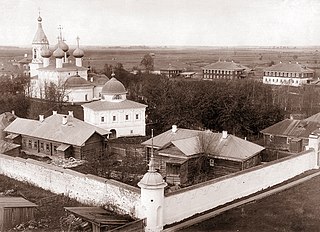
The Gorne-Uspensky Convent or simply Gorny Convent is a monastery in Vologda, Russia. It was active between 1590 and 1924. It is situated in the historic part of the town, named Upper Posad, in the area bounded by the Zavrazhskaya, Burmaginy and Mokhov streets. Several of its buildings are preserved or have been restored, while others are partially or completely in ruins. It comprises a complex of monuments that have been protected by the federal government.

Dormition Cathedral in the selo of Staraya Ladoga, Volkhovsky District, Leningrad Oblast, Russia is one of the oldest churches of Russia, dating from the second half of the 12th century. It is one of the few surviving pre-Mongol buildings in Russia, and the northernmost one. The cathedral is the katholikon of the female Dormition Monastery, one of the several monasteries in Staraya Ladoga, and is located on the left bank of the Volkhov River. The building was designated an architectural monument of federal significance (#4710028015).

The Cathedral of the Assumption of the Virgin or more properly the Cathedral of the Dormition of the Mother of God is the Russian Orthodox cathedral of the diocese of Tashkent in Uzbekistan since 1945. The cathedral was built in 1871 and enlarged in the 1990s, the bell tower was rebuilt in 2010.

Moscow Kremlin Museums is a major state-run museum in Moscow Kremlin. Its roots lie in the Kremlin Armoury museum founded in 1806, the current form of the museum started in 1991. The Head of the museum is Yelena Gagarina, daughter of cosmonaut Yuri Gagarin. There were 424,922 visitors to the Kremlin Museums in 2020, a drop of 86 percent from 2019 due to the COVID-19 pandemic, but it still ranked 46th on the List of most-visited art museums in the world in 2020.

The Pokrovskyi Monastery Cathedral is the oldest cathedral in Kharkiv, Ukraine, built in 1689. The complex includes the seminary, Pokrovskyi Cathedral, Kharkiv episcopal residence and the Temple of the Mother of God Ozerianska.

The Cathedral of the Assumption is a Russian Orthodox cathedral located in the city of Makhachkala, the capital of the Russian Republic of Dagestan. It is the seat of the Diocese of Makhachkala.
























